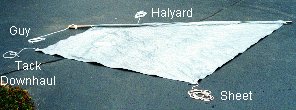(and a poor man's fast motorsailer to boot!)
Tom Sawyer and Huck Finn would have been right proud of this one. I've wanted to put a sail rig on a jonboat (on the upper Mississippi we call them flatboats) for years.
| A great day for sailing! Note offcenter rudder, crooked mast, and white leeboard clipped to port side. It works! |
The idea here was to spend little or no money on the rig, in order to mesh with the
concept of using a readily available jonboat on the cheap. And build it quick!
So we're talking about an afternoon or two, duct tape, polytarp sails, a few
sheet metal screws, clothesline, and a bowsaw to hack down a few locally available saplings.
Spars were green willow, chosen because it was the only species that could be legally cut on the
nearby wildlife refuge, and it grows somewhat straight in the needed lengths.
The rig is an "Arabian lateen" or "settee", #21 out of Bolger's "100 Small Boat Rigs",
selected because Bolger said it would work well with a bendy yard, which
would flatten the sail. It's wonderfully low-aspect, the yard can be
kept light, its very simple to rig, and no boom to slap you in the noggin.


 funk.io
funk.io